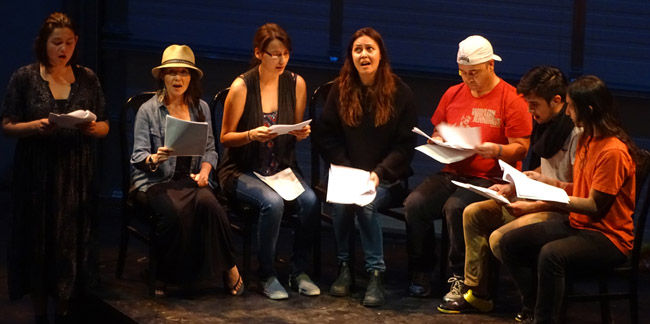Progression of Indigenous theatre at the National Arts Centre

By Suzanne Keeptwo
OTTAWA – Twenty-six years ago, the National Arts Centre (NAC) presented Tomson Highway’s Dry Lips Oughta Move to Kapuskasing (1989),twenty years prior they opened with non-indigenous playwright, George Ryga’s The Ecstasy of Rita Joe (1969) about a First Nations woman (not the Mi’kmaq poet) grappling with city life.
Dry Lips was the only indigenous-authored production at the NAC until 2007 when, under the artistic direction of Peter Hinton, a commitment was made to include Aboriginal art as part of the regular English Theatre (ET) season, starting with Copper Thunderbird by Métis playwright Marie Clements. Since then, Ottawa audiences have seen two indigenous – interpreted Shakespearean plays, a remount of Ryga’s play, another Clements play – at The Great Canadian Theatre Company – and award winning plays from Kevin Loring and Wawaate Fobisher (Grassy Narrows First Nation). Five indigenous-authored mainstage productions in forty-six years.
Yet, as revealed in the NAC’s exploration of indigenous theatre starting last year in Nakoda territory, culminating on unceded Anishnabeg territory at Debajehmujig Storytellers’ Creation Centre in May, there are close to one hundred indigenous-authored plays and more in the works as per the success of Native Earth’s Weesageechak Begins to Dance Festival’s yearly call for new pieces. Plays exposing the issues of what it is to be First Nation, Inuit, or Métis today.”Thirty years ago, Native theatre was an anomaly – an unknown; Tomson Highway blew the doors open on this, starting with Rez Sisters” says humorist and playwright Drew Hayden Taylor (Curve Lake First Nation). “I applaud the NAC for their financial commitment to exploring Native Canadian theatre.” The NAC’s two year research project brought together some of this country’s best of indigenous theatre artists including Margo Kane, Monique Mojica, and Daniel David Moses. “My role was to provide context about those early plays I witnessed or was involved with” says Monique Mojica, second generation theatre artist. “Many of those plays were either self-produced or independently produced.”
Tomson Highway quoted in Dry Lips “Before the healing can take place, the poison must be exposed”, leaving the question of how marketable is indigenous theatre? After all, professional theatres, even federal organizations such as the NAC, must justify themselves through ticket sales. With funding cuts and arm-chair technologies, it is more and more difficult to fill seats, even on complimentary ticket-driven opening nights. Are Canadian audiences willing to be exposed to the “poison” as recently revealed in Cliff Cardinal’s one man tour-de-force huff, presented at the NAC Studio in 2014? Do mainstream audiences want to pay to hear our stories? “After five hundred years of colonization and oppression, we manage to take our voice back and finally tell our stories; chances are those first stories won’t be funny.”” says Hayden Taylor.
Themes like substance abuse, sexual violation, lateral violence, and suicide are all too common for many First Nation, Inuk, and Métis individuals. These are the colonial-impacted poisons that bind us, break us, and must be expunged from us. Indigenous theatre has a huge role in that healing whether it’s in revealing just that or to offer the balance of humour infused profiles. But, do mainstream arts funders and organizations understand the importance of supporting indigenous theatre? As the purse holders, how is it determined what non-indigenous theatre goers need to see or understand of our world? “It is the exception, not the rule, that others accept our work” claims Monique Mojica.
The NAC’s English Theatre pronounces “We are Shaped by Stories. Everyone has a Story to Tell” and Associate Artistic director/co-curator of the indigenous theatre research project, Sarah Stanley states “We want to change the face of Canadian theatre by changing the stories we need to hear as Canadians.” Yet, there is no Native Canadian theatre scheduled for the upcoming 2015/16 season.”We have a long journey ahead of us” says Joe Osawabine, research project advisor and Artistic Director of Debajehumjig Storytellers. Let’s hope two years of research will change that.
Suzanne Keeptwo is a freelance writer residing in unsurrendered traditional Algonquin territory.

